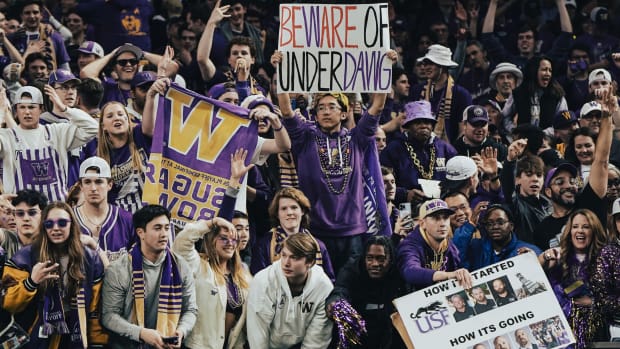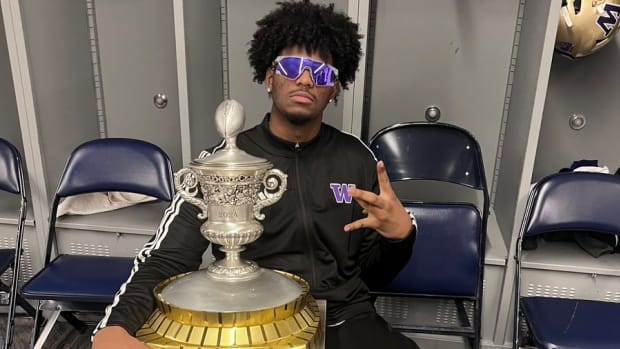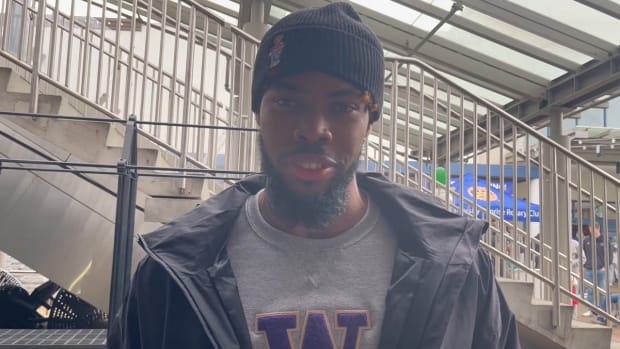One Man's Realignment Vision for the UW, College Football
The University of Washington football team opens the season on September 4 with a home game against Montana.
It's the Pac-12 against the Big Sky.
A glorified scrimmage.
A Montana athletic department payday and not much more.
Hardly competitive football.
That wasn't always the case for these schools.
Seventy-two years ago, the Huskies and Grizzlies were members of the Pacific Coast Conference, both eligible for the Rose Bowl, which was one of just four bowl games offered at the time and a postseason prize that welcomed the UW once a decade and Montana not at all.
Realignment of sorts sent them in radically different directions.
Montana decided to downsize football in 1949 and left the PCC. Meantime, the Huskies tried to buy their way to college greatness by basically purchasing all-everything Los Angeles-area running back Hugh McElhenny on the orders of the school president through an alumni fund. Yes, Hugh made more playing for the UW than he did as an NFL rookie for the San Francisco 49ers.
Four years after McElhenny used up his Husky eligibility, the UW in 1955 found itself caught up in college football's first major scandal and was penalized for improperly paying several other players, something most major schools did post-World War II in an effort to rebuild their manpower-tested programs.
The PCC disbanded.
Nearly every other member school was found guilty of operating a slush fund.
The entire UW athletic program was put on probation.
McElhenny, who's 92 and living in California, once described to the Seattle Post-Intelligencer (and me) how USC paid him under the table for a year and how top schools such as Alabama made him extra-benefits offers before he accepted the UW's off-the-books generosity.
The point of all of this: College football, from coast to coast, always has been big business, whether abiding by the rules or not.
There's no sense in pretending otherwise.
Texas and Oklahoma now want to join the SEC.
Who's to stop them?
No one, of course.
This effectively will dismantle the Big 12, which was the reinvention of the Southwest Conference, a once mighty football empire that disappeared decades ago ... for paying players.
College football, indeed, is known for its quaint traditions.
A lot of hypocrisy was removed when the NCAA recently enabled athletes to use their name, image and likeness for financial gain.
After all, that's what McElhenny did so long ago and others such as USC running back Reggie Bush in more modern times.
Where all this leads is it's time to take the next logical step for college football: Create a super conference.
Football pays the bills. The game needs to be treated differently than any other collegiate sport.
It needs another total realignment.
Currently, there are 65 teams counting Notre Dame playing in the Power Five conferences. Another five schools compete as independents and yet 11 more fairly competitive programs form the American Athletic Conference, all on the cusp of the power brokers.
It's time to take these 80 or so schools and fit them into four conferences — both the SEC and the ACC, representing the power-hungry South; the Big Ten, as the pillar of the Midwest; and the Pac-12, holding up the West, or basically everything to the left of the Rocky Mountains, if not the Mississippi River.
The Big Ten and Pac-12 will need different conference names.
Yes, PCC is available.
Each conference splits into two divisions and sends those eight champions and two selected wild-card teams into a 10-team playoff.
Why 10?
Teams always consider it elite company when they're ranked in the top 10 of the Associated Press poll, not so much if they 're No. 11 or more.
Eight automatically advance and two slide in on merit and by vote, greatly limiting committee decisions.
The top two seeds get a bye.
Yes, that's usually you Alabama and Ohio State.
The SEC would get no more than five teams in this postseason bracket, which is still a fairly significant amount, half the field in a good year for the conference.
Games such as Washington-Montana would disappear forever.
Encourage huge non-conference match-ups between preseason favorites for national TV purposes.
Make all games worth watching.
Use more of the bowls as playoff games, instantly turning them relevant and catering to huge crowds rather than settling for ESPN holiday programming and half-empty stadiums.
For the less fortunate college football teams to finish up, arrange postseason games that match similar schools from different conferences, such as the Pac-12's last-place team against the ACC's last-place finisher.
The Pac-12, or new PCC, would welcome its 12 current schools and pick over the Big 12 scraps for new members, making room for teams such as Oklahoma State, Baylor, TCU and Texas Tech. It could make an exception for a stray school such as independent BYU or Mountain West mainstay Boise State to join.
Hey, Hawaii would be a good road trip, too, and San Diego State is ready to unveil a new 35,000-seat stadium.
There might be some horse-trading done, for a school such as Nebraska or Iowa opting out of the current Big Ten and heading west to the Pac-12.
Anything goes.
Clemson and North Carolina may want to leave the ACC for the SEC.
Let them.
It's time for college football to stop fooling itself.
Group the schools that want to hang out together.
Rightfully pay these players.
No offense to Montana, make every game matter.
It's time for a conference call.
Find Husky Maven on Facebook by searching: HuskyMaven/Sports Illustrated
Follow Dan Raley of Husky Maven on Twitter: @DanRaley1 and @HuskyMaven




